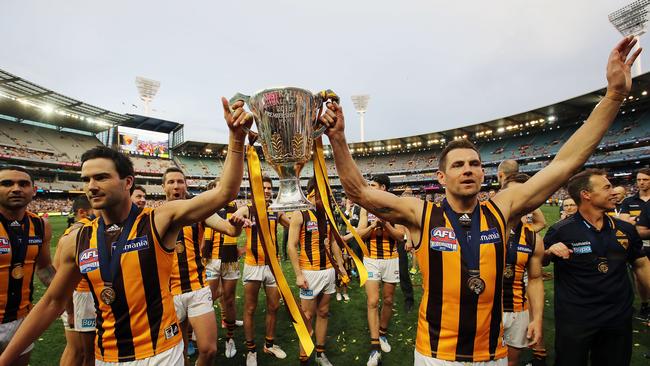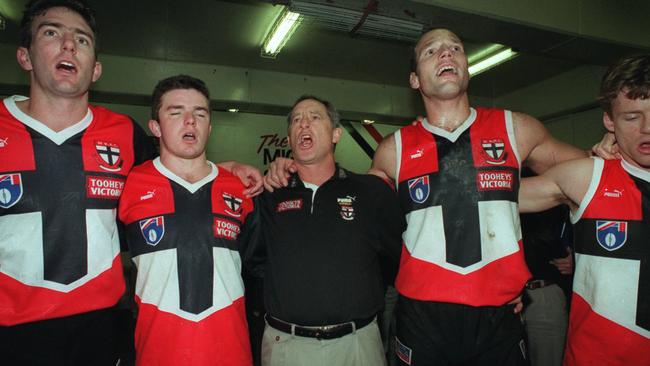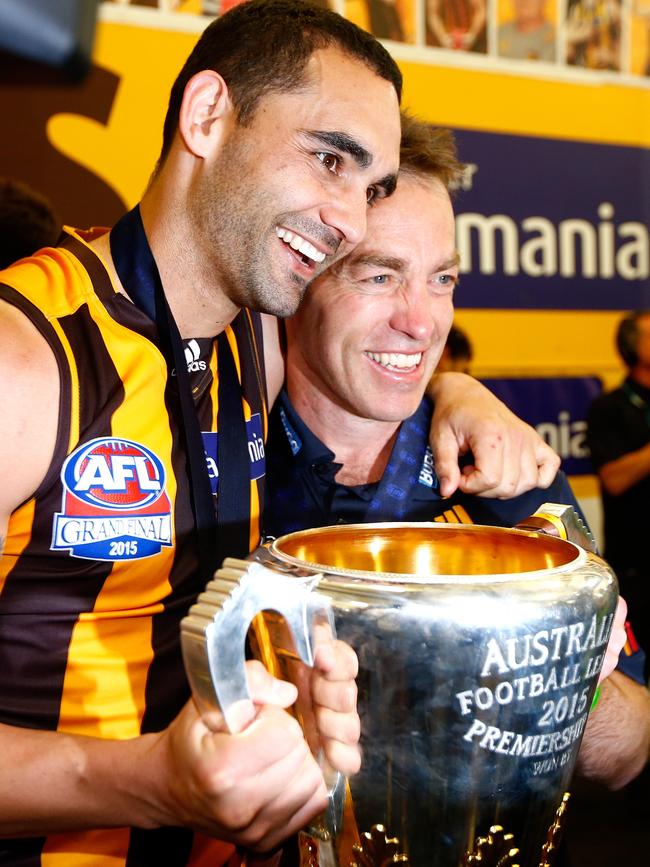Inside story: How Leading Teams helped shape the face of football, from Sydney’s ‘Bloods Culture’ to Hawthorn under Alastair Clarkson
From Hawthorn’s dominance under Alastair Clarkson to Sydney’s famed ‘Bloods culture’, Leading Teams has helped shape some of the most successful teams of the modern era, as SAM LANDSBERGER reports.
Hawthorn
Don't miss out on the headlines from Hawthorn. Followed categories will be added to My News.
Alastair Clarkson tipped in a beer and poured out his soul.
At a Geelong pub early in his time at Hawthorn, Clarkson shed his hardened exterior and opened up as a vulnerable husband, father and son.
He shared childhood stories about growing up in Kaniva, a remote town close to the South Australian border, and plotted his coaching timeline to Waverley.
“That vulnerability certainly had an impact on the group,” dual premiership Hawk Brad Sewell said.
“He told us things we hadn’t heard before and, at that point, wouldn’t have been easy for him to speak about.
“You walk away from a discussion like that seeing a different side to the bloke. He’s not just the coach, but he actually does have a family.”
MICK MALTHOUSE: WHO ARE THE BEST RUCKMEN IN THE AFL?
DEVON SMITH: HOW TAYLOR ADAMS TRIED TO GET ME TO MAGPIES
INSTAGRAM: GARY ABLETT ON WHY HE ‘LIKED’ FOLAU POST
JON RALPH: WHY AFL SHOULD OFFER JAMES HIRD A JOB
It was the first of countless times that Clarkson was ahead of his time.
How often has Luke Beveridge’s emotional intelligence or Damien Hardwick’s heightened engagement been linked to their club’s premierships?
Leading Teams co-founder Kraig Grime, employed by Hawthorn when Clarkson arrived in 2005, laughs at the latest coaching fad.
“We’ve been doing that for 25 years,” Grime said.
“Clarkson opened up and shared his journey — it was very emotional. It allowed the players to go, ‘He’s a real man, how can I not help him?’
“He’s actually here for the right motives. It’s not to own a holiday house and have a nice car.”
At his first Hawthorn session, Grime stood in front of 60 people and asked: “What does the competition say about us?”

“We filled a whiteboard,” he said.
“That’s what people say of you, but what do you want them to say? Why would they say that?
“What behaviours do we currently display that would lead the competition to think that we’re party boys? Or that we’re easy beats?”
In 2003, fellow Leading Teams co-founder Ray McLean helped establish the renowned “Bloods Culture” at Sydney.
McLean asked Swans players at a Coffs Harbour pre-season camp how they wanted to be perceived.
“They spoke about the fact that in the 1940s and ’50s we were called ‘The Bloods’ and were a really hard, physical team,” McLean said.
“That whole essence was really what they wanted to capture and they did. Then you go into the detail — you select your leaders around those behaviours.”
An open leadership vote installed Stuart Maxfield captain and he was the No. 1 driver of The Bloods.
Adam Goodes and Barry Hall missed out. Without open feedback, Goodes might have walked away grumpy and wondering why.
But his teammates told him.
“Goodesy was probably the best professional preparer in the group,” McLean said.
“But he didn’t bring others with him. Once he actually started to bring (young) players along and influence them, he quickly converted.”
Peer assessments commonly involve players filling out three headings on a piece of paper — something to stop doing, start doing and keep doing.

Western Bulldog Jason Akermanis couldn’t deal with his feedback — which targeted his beard, hair and trademark handstand — likening it to workplace bullying as he was sacked in 2010.
Are there dangers handing out what Sewell described as “really confronting feedback” in an open forum?
“They’re not dangers, they’re risks,” McLean said.
“If it was dangerous you wouldn’t do it. The risks are it’s going to cause you to have some conversations.”
Grime insisted they were only conducted in safe environments.
Geelong brought in Neil Balme after its failed 2006 season and he enlisted Leading Teams. With an older list and time running out, the peer assessments didn’t miss.
“You got put out the front and basically hit with a baseball bat from your teammates 25 times,” defender Matthew Scarlett said.
“They tell you all the things you’re doing wrong. They nailed me, Moons (Cameron Mooney) and Gaz (Gary Ablett).”
Mooney and Ablett were jolted when their discipline and training intensity were lashed respectively.
But Scarlett said it had a “good impact” — and the Cats won three out of the next five flags.
LEADING Teams is about empowerment. That’s why Clarkson used to run training sessions at which the coaches wouldn’t speak.
The leaders had to take charge.
Then, the next week the coaches and the leaders were silent. It forced the core group to communicate more.
Sydney coach Paul Roos and his assistants used to observe training from the SCG corporate boxes and watch as their player-led sessions ran seamlessly.
McLean once asked a rival group what would happen if the coaches didn’t turn up to training. He said they’d probably all go home to bed.
The first empowerment example came from St Kilda’s Stan Alves in about 1995, when he stood to the side of training and let his players run a drill.
“And he was rebuked by a board member,” McLean said.
“The perception was Stan should be in the middle yelling and roaring and blowing whistles. That’s fine, but on game day you can’t do that.”

Alves was the first to invite Leading Teams into the AFL and was widely criticised when he broke tradition by naming a leadership group, instead of a sole skipper.
Then, he sent the football world into frenzy by naming Stewart Loewe and Nathan Burke co-captains in 1996.
“It was just too far before its time, really,” McLean said.
“The ultimate part of our work is when you have the players trained enough they behave more autonomously on the field.
“You look at Luke Hodge and Sam Mitchell and they’re all giving direction on the field and (waving their arms). Well, that wasn’t an accident.
“That was six to eight years in the making, because they didn’t come to the club like that.”
LEADING Teams then spread like wildfire.
Tony Shaw introduced it at Collingwood and then his assistant, Danny Frawley, took it to Richmond in 2000.
Tigers captain Wayne Campbell eventually took it to the AFL umpires while Clarkson first saw it at St Kilda, when he was Tim Watson’s assistant in 1999, and then at SANFL club Central District, which signed up back in 1992.
The only clubs that haven’t engaged are West Coast and Greater Western Sydney, although coaches Adam Simpson and Leon Cameron witnessed it as assistants to Clarkson.
Geelong, Hawthorn and Sydney own 36 out of the 88 seasons Leading Teams has run, and they shared nine premierships from 2005-15.

“Wayne Campbell once said when Richmond finished with us that it was the dumbest thing they ever did,” Grime said.
It was a similar story at Hawthorn, which dumped Leading Teams in 2011. Then, after the 2012 Grand Final loss, chief executive Mark Evans called McLean in for an audit.
It led to an explosive pre-season camp in the summer of 2013.
“There were certain things that happened throughout 2012 that you couldn’t shy away from,” Sewell said.
“A couple of guys we hadn’t heard from put their hands up and told a few home truths. It was things that needed to be said and things that needed to be heard.”
Luke Lowden, who was then 22 and yet to play a game, led the conversation as the club’s leaders were told they were saying one thing and doing another, especially in big games.
The behavioural framework agreed on, back when Clarkson was spinning yarns at the pub, was crumbling.

“If you’re walking around thinking you’re a superstar and those behaviours translate on-field and you’re taking shots from the boundary line, you’ve built this misconception of how you’re perceived,” Sewell said.
“That’s when things start to break down. You can see certain passages throughout the (2012) Grand Final where that becomes evident.”
So, what sort of feedback was given at the camp?
“Anything raging from selfish to arrogant to being a pig to poor behaviour,” Sewell said, and it left players “shattered”.
A young group might’ve cracked. But the mature Hawks “copped it between the eyes” and won the next three premierships.
“Everyone was pulling in the same direction and it’s very rare to see the power or capacity of a group of guys with total buy in for three or four years,” Sewell said.
“That’s essentially what Hawthorn had. That’s what you could argue Richmond had for 12-18 months, it remains to be seen where they sit at the moment, and the Bulldogs arguably for two months.”
Clarkson wasn’t immune to feedback and Sewell admitted there were periods when Leading Teams didn’t work. But was it worthwhile?
“Hawthorn without a shadow of a doubt wouldn’t have had the success that we had without them,” he said. “And I’d be surprised if anyone suggested otherwise.”
Originally published as Inside story: How Leading Teams helped shape the face of football, from Sydney’s ‘Bloods Culture’ to Hawthorn under Alastair Clarkson


